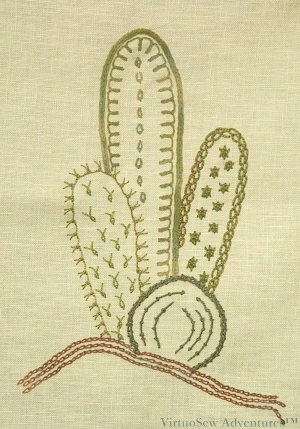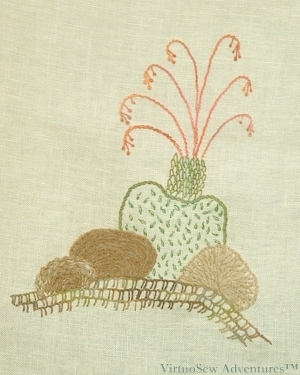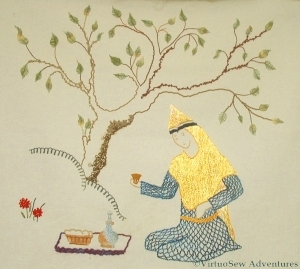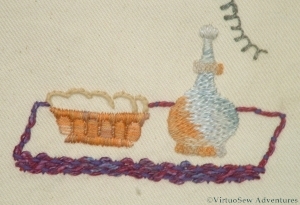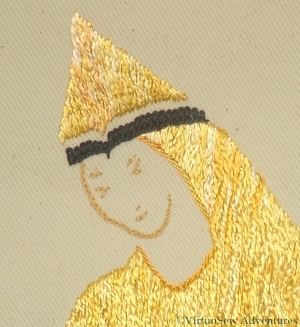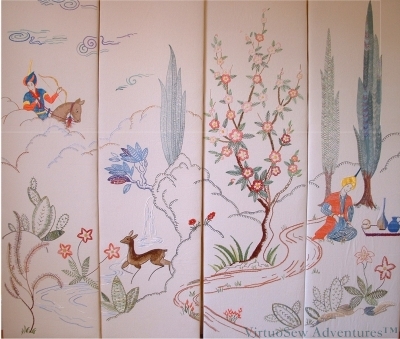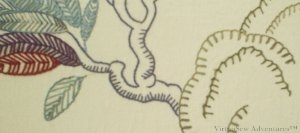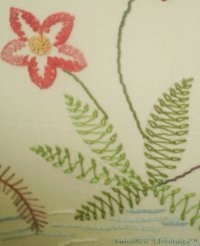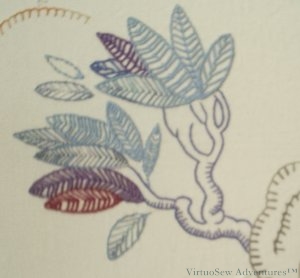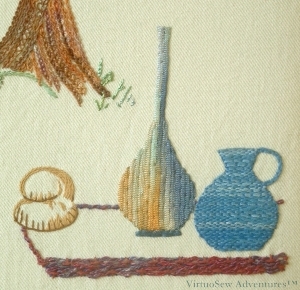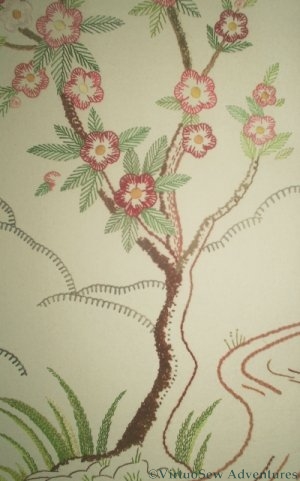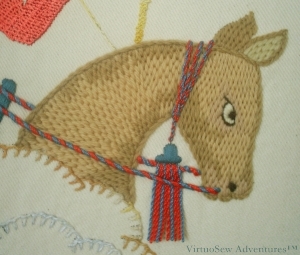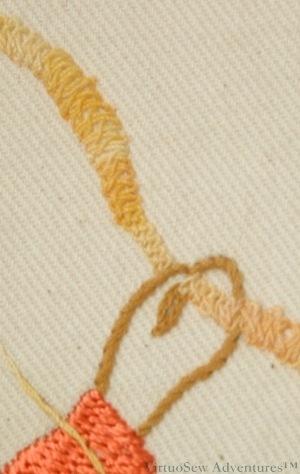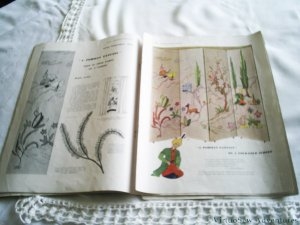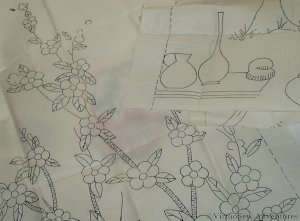Category: Persian Fantasy
Extending the Persian Fantasy – More Cacti
By this time I had run out of the fabric I used for the screen, and I was beginning to realize that if I wanted to continue to embroider in this sort of style I would need to find another suitable fabric. I’d enjoyed the Persian Fantasy so much that I didn’t want to do that…
So I designed two clusters of cacti, to use in experiments. The designs were inspired by the cacti in the Persian Fantasy, but not actually like them, and I worked them on a plain 28count linen intended for counted cross stitch.
I used chain and feather stitches, ornamental blanket stitches, and some isolated stitches as well, all to create variety and and texture. The designs themselves are very minimal, so all the interest in them lies in the combinations of the threads and the stitches.
It wasn’t easy – I wanted to use some of the ornamental stitches I had used in the original piece, but the fabric/thread combinations were very frustrating to work with. The linen threads were too closely set and rigidly finished to respond forgivingly to some of the heavier threads, but they did at least provide me with more opportunity for experimentation. Even if my conclusion had to be that I had to find another sort of fabric for this sort of embroidery!
The rocks in the second design were worked using wool as that provides a different quality of matte effect to the effect of a matte cotton.
The Persian Fantasy – extending the idea
The Persian Fantasy Screen was such fun that I wanted to do some more embroidery in the same style. First of all, it was clear from the original colours that the Prince on Panel One was the same on Panel Four, so I had to create a companion for him, the “Thou” of the text:
A loaf of bread, a flask of wine,
And thou beside me
Singing in the wilderness
And wilderness were paradise enow
I had some help from my mother on this one.. We used the illustrations in her copy of the Rubaiyat to help us with the lady’s costume and to find a different sort of tree for her to sit under. The pictures were from ancient Persian silk paintings, so I hoped that our prince and his partner would recognise one another. I used the same technique for the tree – couched chenille, boucle and loop yarns, and simple shapes for the leaves, although in this case the leaves also used a variegated yarn. I also used a similar idea for the lady’s outfit as I had for the prince, choosing an openwork filling stitch (in this case, Cloud Filling Stitch) for the tunic, and something more solid for the headcovering.
Again, the dishes for the picnic included lustreware, this time a bowl full of bread. This time the lustreware was worked in overdyed stranded cotton. There was also a flask using similar colours to the prince’s lustreware, but worked this time in variegated cottons. The little table (or rug – I never quite decided what it was!) that the picnic is placed on was edged with a complicated couched braid, using an even more complicated textural thread. I can’t for the life of me recall where I bought it, but I do recall that the only possible way to use it was by couching it!
A loose rayon, worked in a sort of halfway stitch between Bokhara couching and Romanian couching, created the lady’s glowing veil, and her headband was worked in braid stitch to give a suitable ornate and luxurious appearance.
I’m not sure that I would use these stitches or threads now. I remember the untwisted rayon was difficult to stitch, very flyaway and prone to catching on my hoop, my fingers, my nails (even though I keep them short) and anything else within range. It looks lovely now it’s done, of course. . .
The Persian Fantasy Finished
As far as I recall, I spent one month each on the first two panels, and then two months on the third, and three months on the final panel. I only embroidered in the evenings when I got back from work, probably not more than a couple of hours each night.
The closely packed fly stitches forming the poplar trees are largely responsible for the length of time the final panel took. I’m not the most patient person and I was nearly at screaming point with fly stitch by the time I had finished them!
The panels are mounted over padded wooden frames. I couldn’t find suitable two-way hinges to make a folding screen (and if I’m honest, we don’t have anywhere where such a thing would be useful!) so I simply hung them on the dining room wall. I don’t think anyone who has come for dinner has ever failed to comment!
Stitching the Persian Fantasy – Four
There was so much going on that I consciously reused yarns, colours or stitches across the four panels in order to maintain some semblance of order. In fact as I moved on to each panel I would lay the completed ones side by side on the living room floor and scramble around putting piles of coloured threads on them. It must have looked highly comical, but my parents (I was still living with them when I embroidered these panels) were kind enough not to laugh. Besides, as long as it works…!
I chose to use one of the Caron Collection threads for the basic outlines of the closer landscape, using Up and Down Blanket Stitch, my favourite blanket stitch variation. I’ve done a bit of hunting because it’s one of the more obscure variations and finally found it at the bottom of Sharon B’s Stitch Dictionary page on blanket stitch variations. For the further landscape or clouds (I never did quite work out what they were), I used a different colour range but the same stitch.
The cacti were worked in a variety of stitches, partly based on the lines of the original transfer, but then extrapolated as the stitches and threads suggested themselves. Although I did use several variegated threads in the flowers and the cacti, most of them are pearl-cotton types, and there is a certain unity provided by the use of the same set of threads wherever those forms appear. There are fly stitches, feather stitches, blanket stitches and sword stitches in this small section. I’ve diagrammed Sword Stitch at the end of this post.
The leaves for the largest flowers were worked using chained feather stitch – I had never worked it before and thought it looked fun. I caught down the long connecting stitches with a single strand of cotton, and was delighted to realise that that gave me the effect of a shadowy vein – one of those serendipitous effects that one cannot foresee, but only rejoice in.
The large flowers had centres of Whipped Spiders Web stitch and the outlines were worked in Rosette Chain stitch. The stems were simply a very heavy rayon cord, couched in place. They may well have been the most straightforward element of the entire four panels!
I couldn’t find a diagram of Sword Stitch on the internet anywhere so I spent a bit of time with a vector drawing package and Barbara Snook’s “Embroidery Stitches”, published by Batsford in 1963. I’ve redrawn the diagrams, changing them slightly where I thought the original used a strange order. When working a row, she seems to recommend working from right to left. The only other advice she gives is that the longest arm should point downwards – clearly that is the blade of the sword.
Stitching The Persian Fantasy – Three
I tried very hard to get a photo that does justice to the waterfall here, because it is another example of what I mentioned when I was discussing the gazelle, but I’ve not succeeded very well, I’m afraid.
The interesting point about the waterfall is that it looks like a trivial piece of design – just a few lines – and yet when I came to embroider it, I realised that it would be spoilt if I added “watery” effects with sparkling thread or metallics. I ended up stitching it very simply in stem stitch, using three colours of pearl cotton.
In real life (I wish I were better at photography!) this looks more like a waterfall than a few simple lines have any right to. I’ve looked at this panel over breakfast for ten years now, and I still can’t work out quite how the designer managed to do it!
This tree is a different matter. It doesn’t look much like a real tree, and it isn’t intended to. It is a purely decorative, “tree-ish” element of the design.
I’m coming to realise that the success of these panels rests partly on this balancing act, in which some of the elements look more realistic than others.
Something for us all to try, perhaps!
Stitching the Persian Fantasy – Two
I enjoyed working on the prince’s picnic on panel four. The tall carafe is created using a variegated knitted ribbon (from Stef Francis), and has been used as if appliquéd. The inspiration here was those strange lustre-glazes that show widely differing colours in different lights, and I had great fun choosing particular sections of the yarn to create the effect. The blue jug is much more homespun (sorry – couldn’t resist!), using a Soft Cotton, this time inspired by coiled clay pots – a technique I remembered trying at school, although it was much easier in embroidery! Then there was the loaf of bread, using three shades of a plain matte, round cotton yarn, and the rug (or table – I’m not sure which) bordered with a complex border stitch in a strongly textured yarn.
The bark of the flowering tree on Panel Three was worked using various bouclé and other effect yarns, couched to the surface randomly. The basic design is so stylised that I was careful not to be naturalistic. I used a variety of yarns from a Texere Yarns Inspirations pack and caught them down with a single strand of stranded cotton, in loops and wavy lines. The flowers and leaves were working in plain stranded cottons. The flowering tree was already so dominant in the panel that it really didn’t need much in the way of emphasis from the yarns other than the bark. The tall grasses at the foot of the tree are in stranded cotton too, using feather stitch. I’m not sure that I would do this panel in the same way now, although I think that using satin stitch and long and short stitch, as in the original, might make it look a little serious, rather than decorative and fun.
And I wanted it to be fun.
Stitching the Persian Fantasy – One
I’m glad to say that stitching the Persian Fantasy screen was just as much fun as I hoped it would be! I didn’t follow the instructions in the magazine, not least because it called for “Anchor Flox” , and no-one I could find even knew what that was! I’ve since discovered that it was a very shiny thread, something like a pearl cotton, but made of rayon. I was going to stick with a single type of thread, and conventional stitches, but my mother suggested that I should Be More Adventurous, so I was. I have been grateful to her ever since, as I had enormous fun playing with the threads and stitches.
The four panels show
- the hero out hunting,
- a gazelle in front of a waterfall, perhaps the object of his hunt,
- a flowering tree, and
- the hero again laying out a well-deserved picnic to share with his lady who so far has not appeared.
It is very stylised, very Thirties, but clearly inspired by early Oriental silk paintings. I have a couple of modern ones in a similar style, in fact – inherited from Grandmama, along with the lacquer box!
My knowledge of horses is limited to the direction in which they are going, but I remembered hearing from my horse-mad cousin that horses can get pretty shaggy, and that the lovely glossy look you see on a racehorse is due partly to the horse having had a good haircut. So when I came to do the prince’s steed on the first panel, although I didn’t want him glossy (I wanted the Prince to be glossy), I did want him to look cropped rather than shaggy. So I chose tapestry wool and brick stitch, slightly bent to follow the direction of the coat. I gave him a darkly staring, focused eye, like a warhorse on the Bayeux Tapestry, and matched his reins to the Prince’s clothes, using two colours of Anchor pearl cotton, matching the two colours of Anchor Marlitt rayon thread, twisted together to create cords. The fringe on the headpiece was created using twisted single lengths of pearl cotton, the raw ends plunged and the twisted cords hanging free. I’m still pleased with the horse, and I don’t think I would do him differently now.
The running gazelle on the second panel makes a very good contrast with the Prince’s horse. She was worked using long and short stitch in Paterna crewel wool, with some mixing of colours in the needle, and I quite explicitly aimed for a slightly ragged look around the haunches, although in keeping with the very stylised feel of the whole design, I worked a neat, careful, dark outline of stem stitch. I particularly like the way the designer has made her very clearly a design, not an animal portrait, but at the same time, the single lines for the lower legs are so very reminiscent of the fragile-looking legs of gazelles and other deer.
The Prince’s bow is worked using Braid Stitch, using a mercerised variegated cotton. Archaeological and historical records show that the ancient bows could be very highly decorated while still retaining all their power as a weapon, and I was thinking of descriptions I had read (archaeology is another interest of mine) of bows using horns as the ends, and laminated wood (lamination was invented earlier than you might think) for the main section, all decorated with gold wire inlay. Naturally, all you can see on the embroidered bow is the inlay!
The Persian Fantasy Screen
There was one project in those magazines that I positively ached to do, but it was a four fold screen inspired by the Rubayat of Omar Khayyam and Grandmama did not have all of the four magazines that it was in. I resigned myself to looking wistfully at the picture, and got on with life – O-levels, A-levels, degree.
Then Grandmama died, and I inherited the black lacquer box. I tried to work out whether I could re-create the transfers I did not have from the photograph of the screen, but my skills with a pencil were not up to the task. And computers, in those days, did not have the fabulous range of image editing facilities now available at the click of a mouse.
Needlecraft magazine was launched. I subscribed promptly, and wrote to the Letters page, describing the panels, naming the issues, and asking, could anyone provide me, perhaps, with a photocopy of the missing stitch diagram? They could, and they did, but then of course I had to find some fabric.
I was still looking, when a rather bulky parcel arrived in the post, which changed the direction of my search. My correspondent had the actual transfers, but she had wanted to check with her daughter to see whether she wanted to stitch the screen before sending them off. Suddenly, instead of looking for a fine fabric to produce the panel at the size of the stitch diagram, – much more excitingly – I was looking for a somewhat heavier, upholstery-type fabric..
I also had to gather my nerve. I’d seen the pictures and sketches in the magazine, but I hadn’t quite realised just how big those panels were – each one is about eighteen inches wide by five foot high!
I finally found some material, thanks entirely to a family friend who at that time owned a weaving mill in Lancashire. A loomstate cotton twill – so rather than having all the various bleaches and finishes applied, and the fabric shrunk to its’ finished state and difficult to embroider, it was perfect for playing with heavy ornamental threads, and the soft creamy colour would provide a pleasant and restful background.

